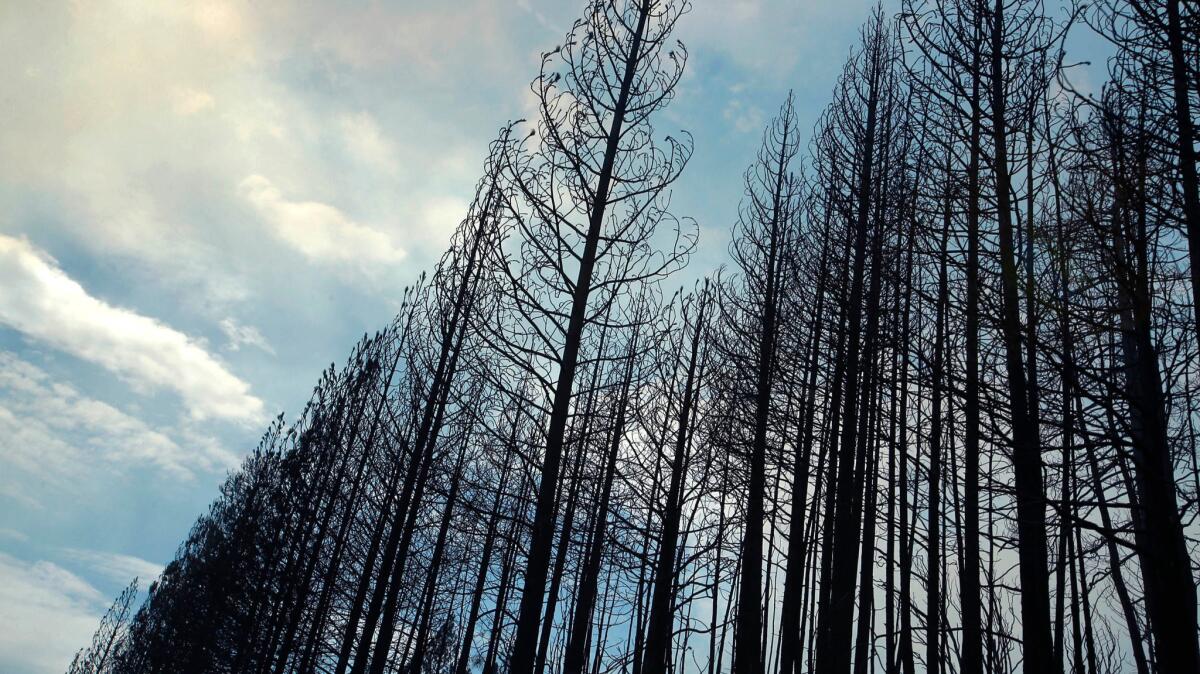How ‘Goldilocks fires’ can give rise to vibrant bird communities years after a forest blaze

- Share via
California has a complicated relationship with wildfires.
Though drought and climate change have helped make conflagrations in the Sierra Nevada increasingly powerful, fires aren’t all bad.
Wildfires, under the right conditions, help to increase the variety of birds found in the forest, according to a recent study published in Proceedings of the Royal Society B.
“I’m a bird-watcher in addition to a scientist, and bird-watchers usually don’t go into areas following a fire,” said study leader Morgan Tingley, an ecologist and ornithologist at the University of Connecticut. “I think there’s a general perception out there that fire is not good for wildlife.”
To find out how birds respond to wildfires, Tingley and colleagues from the Institute for Bird Populations, the Cornell Lab of Ornithology and the U.S. Forest Service surveyed about 100 sites in the Sierra that had burned in the past 10 years. Between 2009 and 2014, a team hiked and camped in sometimes-remote areas to count all the bird species they could spot.
In more recent burn areas, bird communities looked about the same, regardless of how severe the fire had been. But areas that experienced a fire a decade earlier showed a remarkable array of bird life, the study found.
“It’s not that interesting two years after fire,” Tingley said. But eight to 10 years later, “these areas are thriving and vibrant.”
Post-wildfire bird diversity depends on what Tingley calls “Goldilocks fires” — those that burn not too hot, not too cold, but just right.
Fires usually don’t burn uniformly. Depending on the area’s topography, weather, fuel availability and other factors, some patches of forest burn more than others. As a result, some areas are destroyed and trees die. In other areas, trees might be left standing, but the flames clear the forest floor of shrubs and plant matter.
Researchers call this mosaic of fire severity “pyrodiversity.” With time, these mixed-severity fires create a “magic combination” that can inject biodiversity into the landscape, Tingley said.
As time goes on, different plant communities take over depending on the severity of the fire that took place in the area.
Unburned or mildly scorched areas survive as a healthy forest, but harder-hit patches change more significantly. If a fire burns hot enough, the flames rise to the tops of the trees, burning away their canopies. This allows light to reach the ground, eventually promoting the growth of thick chaparral. Some dead trees, called snags, might remain standing.
The growth of different plant communities in the decade following a wildfire also gives rise to different varieties of bird. Where there was once one type of habitat, there are now many.
About a year after the smoke clears and the ash settles, the black-backed woodpecker is one of the first birds to show up.
Woodpeckers rebuild the post-fire ecosystem by pecking cavities in dead trees. This makes niches for other birds and small mammals, such as flying squirrels, that might hide and hunt in the tree trunks.
Black-backs, which are considered uncommon or rare in California’s mountains, serve as an indicator species of post-fire forest health. When the woodpecker population booms, it tells forest managers and scientists that the ecosystem is doing well.
While the study found that a fire that’s “just right” can benefit bird diversity, high-severity fires that level entire forests are not good for birds or other wildlife.
This bodes poorly for the future, as climate change threatens the forest with more frequent and increasingly severe wildfires.
In the western United States between 1984 and 2011, the number of large fires increased at a rate of seven fires per year, while the total area burned increased at a rate of about 137 square miles (or 355 square kilometers) per year, according to a 2014 study published in Geophysical Research Letters.
See the most-read stories in Science this hour »
On top of that, many places in the Sierra consist of uniform stands of trees or are overgrown with flammable shrubs and debris — the result of a century-long policy to snuff out blazes as quickly as possible. It’s these types of forests that can easily burn to a crisp, Tingley said.
Going forward, scientists and forest agencies must manage the forests to “burn better,” Tingley said. That means making sure there’s a variety of differently aged trees — some young and flammable, some older and hardier — to help prevent catastrophic fires.
“We want to build strong and resilient communities to help withstand all these things that we throw against them,” including climate change, invasive species and land-use changes, Tingley said.
Follow me on Twitter seangreene89 and “like” Los Angeles Times Science on Facebook.
MORE SCIENCE NEWS
The bigger an animal’s yawn, the bigger its brain, study finds
The lowly earthworm poses a dire threat to this California island
As cities get warmer, their trees lose some of their ability to take carbon out of the atmosphere







